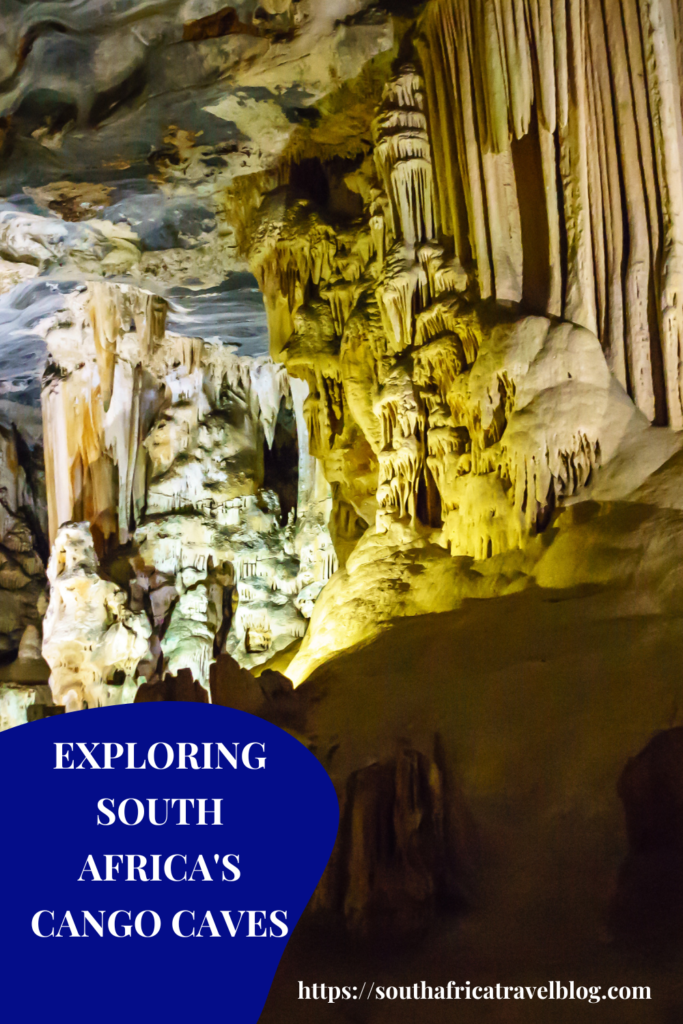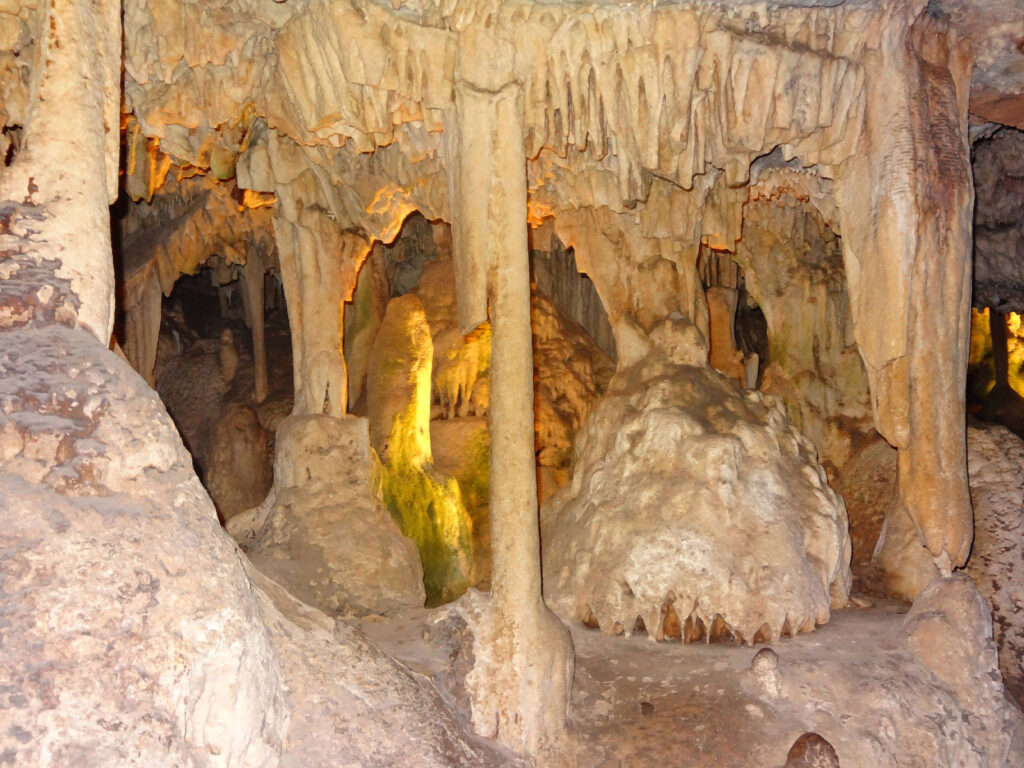South Africa’s Cango Caves are the most visited show cave in South Africa. It is also South Africa’s oldest tourist attraction. When you visit Oudsthoorn, stopping at the Cango Caves is a must-do! This article covers everything you may want to know about a visit to South Africa’s Cango Caves, including where they are, how to get there, the Cango Caves tours and what a Cango Caves tour is like!

What Are the Cango Caves?
South Africa’s Cango Caves are a system of limestone caves located at the bottom of the Swartberg Mountains of South Africa. The Cango Caves have striking rock formations.
The Cango Caves are the most visited cave in South Africa. Other South African show caves include the Sodwana Caves, the Sterkfontein Caves and the St Blaize Cave.
Where Are South Africa’s Cango Caves?
The Cango Caves are just outside the town of Oudtshoorn in the Western Cape Province of South Africa. Oudtshoorn is not part of the Garden Route, but it is just a short drive from the Garden Route to Oudtshoorn.
Oudtshoorn is located in a region called the Klein Karoo or Little Karoo. The Swartberg Mountains separate the Little Karoo from the Great Karoo (Groot Karoo). It is the least karoo-like as it is in a well-watered area.
The nearest airport is George Airport, approximately 50 kilometres from the Cango Caves. If you’re travelling from Cape Town, it will take you between 5 and 6 hours by car to get to the caves.
How to Get to The Cango Caves
The beasiest way to get there is by car. For the best deals on rental cars, click here!
Several tours visit the Cango Caves, including:
- Swartberg Mountain Circular ALL Inclusive Day Tour
- 6-Day Garden Route & Addo South African Adventure from Cape Town
- 7 Day Garden Route with Addo, Cape Point and Winelands Small Group Combo Package
- 10 Day Cape Town Complete Combo including Garden Route Guided Small Group Tour
The Contact Details for The Cango Caves
Address: Cango Caves R328, Cango Valley, Oudtshoorn, 6625, South Africa
Phone: +27 82 303 0029
Email: reservations@cangocaves.co.za
Website: Cango Caves
History of The Cango Caves
The caves were created over millions of years. Underground water trickled into the limestone rock and dissolved it, which created openings in the rock. Over time, these openings became more extensive, and a series of tunnels and chambers developed. The water seeped into these caverns to form stalagmites and stalactites.
Not sure what the difference between stalagmites and stalactites is? Stalagmites rise from the cave floor, while stalactites hang from the cave’s roof.
The caves may have been used by the San and Khoekhoe people who lived in the area thousands of years ago.
The Cango cave was discovered in 1780. There are two possibilities for who discovered the caves. The first story is that Klaas Windvogel, a herder discovered the caves while searching for lost cattle. The second version is that the farmer, Jacobus van Zyl, discovered the caves and that Klaas Windvogel did the first exploration tour.
After the discovery, the caves became a popular tourist attraction. Tours to the caves started in the 1890s. Apparently, Johnnie van Wassenaar, the first full-time guide, discovered many side chambers in the caves.
Unfortunately, the visitors damaged the caves and rock formations when they tried to take pieces with them as a souvenir. In 1820, the Governor of the time, Lord Charles Somerset, issued the first Caves Regulation and banned the collection of souvenirs from the cave. He also made it expensive to enter the caves.
The caves became a national monument in 1938.
How Big Are the Cango Caves?
The surveyed length of the caves is 4 kilometres or 2.5 miles. The caves consist of three sections: Cango 1, Cango 2 and Cango 3. Visitors to the caves can only visit Cango 1, which is about a quarter of the entire cave system. Cango 1 has spotlights highlighting the grand halls, limestone formations and caverns.
Tours at the Cango Caves
The Cango Caves are open every day of the year except Christmas. The tours operate every hour between 9:00 and 16:00. It is best to book a tour in advance, as the Cango Caves are a popular attraction. The number of people per tour is strictly controlled for safety reasons.

The Cango Caves are slightly stuffy and humid inside. Wear lightweight clothing, especially during summer. The temperature inside the cave system stays constant at 18 degrees Celsius.
Neither of the tours is suitable for wheelchairs, children under 8, pregnant women or anyone with claustrophobia, high blood pressure, asthma or muscular ailments.
The tour guides are experienced and accredited. The guides speak different languages, including English, Afrikaans, German and French.
You can choose from two different tours:
The Heritage Tour
The Heritage Tour is the standard tour that most visitors do. It is the easiest of the two tours and caters for visitors of all ages. It gives you an excellent introduction to caves if you’ve not been inside a cave. Furthermore, it focuses on the most significant chambers of the complex of caves. Once you enter the entrance area of the cave, you will be surprised at how spacious the caves are at this point.

The Cango Caves were inhabited from the early Stone Age, and cave drawings from this period are on the cave walls. These drawings depict scenes of this early life.
Nature is an incredible artist! The stalagmites and stalactites inside the Cango Caves are impressive. The lighting in the cave also adds to the ambience and beautifully highlights specific features inside the cave. Visitors will see a series of dripstone caverns in the caves.
Chambers on the Heritage Tour
The first chamber visitors see is Van Zyl’s hall, named after the original owner of the Caves. It features many impressive stalactites. From here, the tour goes to Botha’s Hall, which is as large as a soccer field and from where the giant eagle formation is visible.
The most notable feature in the massive cavern is the Madonna and Child. It’s a unique formation that looks like the figure of Mary cradling her baby in her arms.
Another highlight in the caves is Cleopatra’s Needle, a long stalactite estimated to be about 150 000 years old. The different chambers have interesting formations and names. Some of the chambers we encountered were the Organ Pipes, Frozen Waterfall and the Ballerina.

The tour ends at the Drum Room, where visitors return to the entrance with the same route, just in reverse.
During the tour, the guide switched off the lights inside the cave. Without lights, it is completely dark inside the caves. While the lights were off, our tour guide sang a song to show us how fantastic the acoustics inside the caves were! This was such a unique experience!
There are many steps in the Cango Caves. When the steps are wet, they can be slippery. Remember to wear shoes with non-slip soles and be careful!
The Adventure Tour
This tour is slightly more expensive and only for those who love adventure, as the tour requires visitors to crawl through narrow spaces. This is a real caving experience which doesn’t require caving equipment. The whole route is lit. The number of visitors means the route is clean, and crawling through the narrow tunnels doesn’t mean you will get dirty.

The tour starts the same as the Heritage Tour but continues deeper into the caves from the Drum Room. It starts with Jacob’s ladder, which takes over 200 steps to climb. From there, it goes to the Lumbago Alley with its low ceiling – for more than 28 metres, the roof is just 1.20 metres high. Then, the tour descends via an iron staircase to King Solomon’s Mines. Here, visitors have to crawl a round course. The Tunnel of Love initially has a height of 74 cm, but it ends at 30 cm. The Devil’s Chimney is between 45 cm and 3.50 metres long. The Devil’s Post Box has a height of 27 cm.
Remember that you cannot turn back once you start the Adventure Tour, and must push through to the end.
Learn More About South Africa’s Cango Caves
Visitors can learn more about the caves at the interpretive centre at the Cango Caves Complex. There is an auditorium where visitors can see a short film about an expedition to the Wonder Cave in Cango 2. On the property, there is also a restaurant and a curio shop where you can buy African crafts, gemstones and books.
Other Attractions Near South Africa’s Cango Caves
The Cango Caves are near Wilgewandel Holiday Farm, a fun place with several family activities, including putt-putt (minigolf), donkey cart rides and a zip line. Other attractions in the Oudtshoorn include the Cango Wildlife Ranch.

Oudtshoorn is considered the ostrich capital of the world, and there are world-class working ostrich farms where visitors can learn about ostrich farming and buy ostrich products, including leather goods and coloured ostrich feathers.
Another attraction nearby is De Kombuys Estate, a two-hundred-year-old Cape Dutch Farm in the foothills of the Swartberg mountain range. Here, visitors can try the estate’s wines and free-range Wagyu steaks in the on-site restaurant called The Marbled Wagyu. The De Kombuys Estate also offers luxury accommodation.
Accommodation Near South Africa’s Cango Caves
The nearest town to the Cango Caves is Oudtshoorn, where many accommodation options are available:
FAQs About South Africa’s Cango Caves
These are frequently asked questions, with answers, about the Caves:
How Much Does It Cost to Enter South Africa’s Cango Caves?
The Heritage Tour costs R170 for an adult and R120 for a child, whereas the Adventure Tour costs R240 for an adult and R170 for a child.
How Long Does the Cango Caves Tour Take?
The Heritage Tour’s duration is 60 minutes, and the Adventure Tour takes 90 minutes from beginning to end.
Do You Need to Book for The Cango Caves?
The caves are a popular attraction. It is best to make a booking to ensure you get a spot on the tour of your choice.
What Is the Biggest Cave in South Africa?
The Cango Caves are one of the largest and longest cave systems globally.
Who Owns the Cango Caves?
It belongs to the South African Government.

